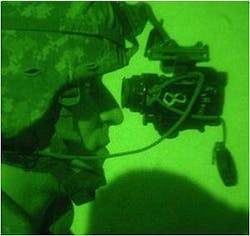DARPA launches plan to use commercial processes for developing sensors in record time
ARLINGTON, Va., 2 Oct. 2012.Military sensors experts at the U.S. Defense Advanced Research Projects Agency (DARPA) in Arlington, Va., are approaching industry to find new ways to use commercial processes for developing sensors in record time.
The DARPA Strategic Technology Office issued a broad agency announcement late last week (DARPA-BAA-12-61) for the Adaptable Sensor System (ADAPT) phase 2 program that seeks to enable companies to develop sophisticated sensor systems in one year or less, rather than three and eight years it takes today to develop military sensors.
The second phase of ADAPT seeks to speed sensor development with commercial processes that typically have not been used in military sensor systems development by avoiding developing sensors from scratch to meet a specific system need in stovepipe fashion.
DARPA scientists would like to draw from expertise in commercial consumer electronics development that relies on investments in reference designs that demonstrate technology and form the basis consumer electronic products. These reference designs enable consumer electronics systems integrators to develop and upgrade products quickly, DARPA officials say.
The first phase of the ADAPT program developed core sensor hardware and software by capitalizing on commercial smartphone technology, including processors; data storage; fast and low-power communications; GPS navigation; compass, accelerometer, and gyro orientation; sensor and communications interfaces; the Android operating system; sensor management; distributed database and communications protocols; and display utilities.
The program's second phase seeks to create reference designs that use this core technology that enable system integrators to develop and deliver new sensor missions in less than 12 months.
The ADAPT phase 2 program has three topic areas: reference designs, reusable core software, and core and ancillary hardware. Proposals may address only one topic area.
DARPA primarily is interested in inexpensive open-systems generic reference designs that enable a broad range of systems integrators to develop sensor systems quickly that support several military sensor missions. These reference designs are meant to communicate technical capability, and should use government-furnished ADAPT core technology.
Today the ADAPT program has one reference design in development for unattended ground sensors that demonstrates how the ADAPT core technology can be used in sophisticated, distributed stationary sensor systems of 500 nodes.
Reusable core software seeks to expand existing ADAPT core software capabilities that runs on an ADAPT general-purpose processor, graphics coprocessor, field-programmable gate array (FPGA), radios, and sensor and GPIO interfaces.
Core and ancillary hardware seeks to enhance existing ADAPT core hardware, and should be designed and manufactured using commercial processes. Power consumption is a significant consideration. ADAPT phase 2 demonstrations are scheduled for spring and summer 2014.
Companies interested should respond no later than 30 Nov. 2012 via the DARPA Strategic Technology Office website at https://stobaa.sainc.com. For questions or concerns contact DARPA by e-mail at [email protected].
More information is online at https://www.fbo.gov/spg/ODA/DARPA/CMO/DARPA-BAA-12-61/listing.html.
Follow Military & Aerospace Electronics and Avionics Intelligence news updates on Twitter
